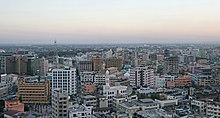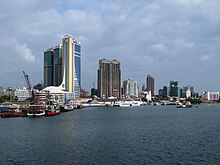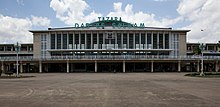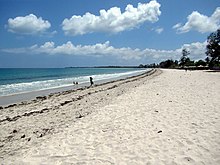Dar es Salaam (region)
| Dar es Salaam | |
|---|---|
| Basic data | |
| Country | Tanzania |
| Capital | Dar es Salaam |
| surface | 1393 km² |
| Residents | 4,364,541 (2012) |
| density | 3133 inhabitants per km² |
| ISO 3166-2 | TZ-02 |
Coordinates: 6 ° 46 ′ S , 39 ° 7 ′ E
Dar es Salaam is one of the 31 regions in Tanzania . It borders the Indian Ocean to the north and east , and the Pwani region to the south and west .
geography
The region includes the capital Dar es Salaam and the surrounding country. It has an area of 1393 square kilometers and a population of 4,364,541 (as of 2012). The climate is tropical, Aw according to the effective climate classification . The annual average temperature is 25.9 degrees Celsius, it rains 1089 millimeters annually.
|
Climate table Dar es Salaam
Source: climate-data.org
|
||||||||||||||||||||||||||||||||||||||||||||||||||||||||||||||||||||||||||||||||||||||||||
history
The name "Dar es Salaam" is derived from the Arabic expression "Bandar-ul-Salaam", which means "harbor of peace". It was named a city in 1920. In 1961, Dar es Salaam became the capital of the independent Tanganyika and remained capital of the United Republic of Tanzania until 1970 after its union with Zanzibar . In that year the capital was relocated to Dodoma .
Administrative division
The region has been divided into five districts since 2016 (as of 2020):
| Surname | surface
km 2 |
Residents
2012 |
|---|---|---|
| Temeke | 240 | 1,162,915 |
| Kigamboni | 416 | 205.966 |
| Ilala | 210 | 1,220,611 |
| Kinondoni | 271 | 929,681 |
| Exercise | 260 | 845.368 |
population
The population pyramid shows the shape typical of large cities with a bulge in the age group 15 to 34 years. This indicates immigration. The literacy of those over five is high, 95 percent for men and 93 percent for women (as of 2012).
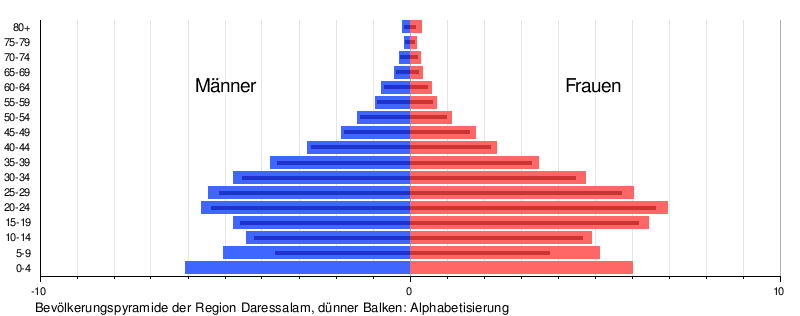
Facilities and services
- Education: Dar es Salaam has 377 public and 286 private primary schools, as well as 138 public and 186 private secondary schools. There are five universities in the city, the oldest being the University of Dar es Salaam, founded in 1970.
- Health: 38 hospitals, 58 health centers and 436 pharmacies provide medical care for the population.
Economy and Infrastructure
Dar es Salaam is the economic center of Tanzania. It is home to over 500 large industrial companies, major banks and insurance companies, and there are well-developed transport networks.
- Industry and Commerce: Industry and commerce employ 62 percent of Dar es Salaam's population. The city is the financial center of Tanzania with 34 banks. The textile industry, the food processing industry, the beverage industry and the chemical industry are also located here. In 2017, 60,887 trading licenses were issued, an increase of four percent compared to 2016.
- Agriculture: Around thirty percent of the agricultural products consumed in the city are produced in the region. It is mainly fruit and vegetables that are cultivated because of the short transport routes.
- Tourism: Dar es Salaam is interesting for tourists because of its infrastructure, its hotels and because of its Arabic, German and English history. It also offers sandy beaches on the coast of the Indian Ocean and coral reefs on the offshore islands of Mbodya, Bongoyo and Pangavini.
- Port: In 2018, the port of Dar es Salaam handled 14.4 million tons of cargo and 1.9 million passengers.
- Airport: Julius Nyerere Airport is by far the largest airport in Tanzania with 1,186,000 passengers in 2018.
- Railway: All major railway lines in Tanzania have their starting point in Dar es Salaam. The Tanzania – Zambia Railway to the southwest runs via Mbeya to Zambia, the Tanganyika Railway (also called Central Line) connects Dar es Salaam with Tabora and Mpanda and the railway line to the north, which was reopened in 2019, goes to Arusha .
- Roads: From Dar es Salaam the national road T7 leads along the coast to Mtwara in the south and the national road T1 to Mbeya in the southwest and on to Zambia . From the T1, the T2 branches off in the north to Arusha and the T3 to Dodoma in the northwest and on to Rwanda .
Nature reserves, sights
- Pande Game Reserve: This twelve square kilometer reserve was established in 1990. It is an area with high biodiversity, it is home to 164 species of plants, 142 species of birds and 56 species of butterflies.
- National Museum: The museum shows the history of Tanzania, starting with a section on the cradle of mankind to rock paintings and contemporary art.
- Dar es Salaam marine reserve: The islands of Mbudya and Bongoyo in the north and their coral reefs encompass a marine reserve with extensive seagrass meadows, sea turtles, rare crabs and a variety of birds.
Others
The University of Vienna has had a partnership agreement with the University of Dar es Salaam since 2002, and the University of Göttingen has had a cooperation since 2005.
Web links
Individual evidence
- ↑ a b c d City Profile | Dar es Salaam City Council. Retrieved February 9, 2020 .
- ↑ Tanzania Regional Profiles, 07 Dar es Salaam Regional Profile. (PDF) The United Republic of Tanzania, 2016, p. 15 , accessed on February 9, 2020 .
- ↑ Dar es Salaam climate: Average Temperature, weather by month, Dar es Salaam water temperature - Climate-Data.org. Retrieved February 9, 2020 .
- ↑ Statistics | Temeke Municipal Council. Retrieved February 10, 2020 .
- ↑ Statistics | Kigamboni Municipal Council. Retrieved February 10, 2020 (Swahili).
- ↑ Category publications | Ilala Municipal Council | Strategic plan. (PDF) pp. 16–18 , accessed on February 10, 2020 (English).
- ↑ History | Kinondoni Municipal Council. Retrieved February 10, 2020 .
- ↑ History | Ubungo Municipal Council. Retrieved February 10, 2020 .
- ↑ Tanzania Regional Profiles, 07 Dar es Salaam Regional Profile. (PDF) The United Republic of Tanzania, 2016, pp. 18, 49 , accessed on February 9, 2020 .
- ↑ a b Statistics | Dar es Salaam City Council. Retrieved February 9, 2020 .
- ↑ All 5 universities in Dar es Salaam | Rankings and Reviews 2020. Accessed February 10, 2020 .
- ↑ a b c Single Economic Activity | Dar es Salaam City Council. Retrieved February 10, 2020 (Swahili).
- ↑ Tanzania in Figures 2018. (PDF) National Bureau of Statistics, June 2019, p. 66 , accessed on February 10, 2020 .
- ↑ Tanzania in Figures 2018. (PDF) National Bureau of Statistics, June 2019, p. 67 , accessed on February 10, 2020 .
- ↑ Lonely Planet: Getting around Tanzania by train. Retrieved February 10, 2020 .
- ^ Daily News, Tanga-Moshi Railway Relaunched. October 31, 2019, accessed October 31, 2019 .
- ^ Tanzania Trunk Road Network. Retrieved February 10, 2020 .
- ^ Pande Game Reserve, A Biodiversity Survey. (PDF) 2003, p. 8 , accessed on February 10, 2020 .
- ↑ Dar National Museum in Dar es Salaam, Tanzania | Africantourer. Retrieved February 10, 2020 .
- ↑ Marine Parks | Marine Reserves. Retrieved February 10, 2020 .
- ↑ Dar es Salaam. Retrieved February 10, 2020 .
- ^ Georg-August-Universität Göttingen- Public Relations: University of Dar es Salaam - Georg-August-Universität Göttingen. Retrieved February 10, 2020 .


